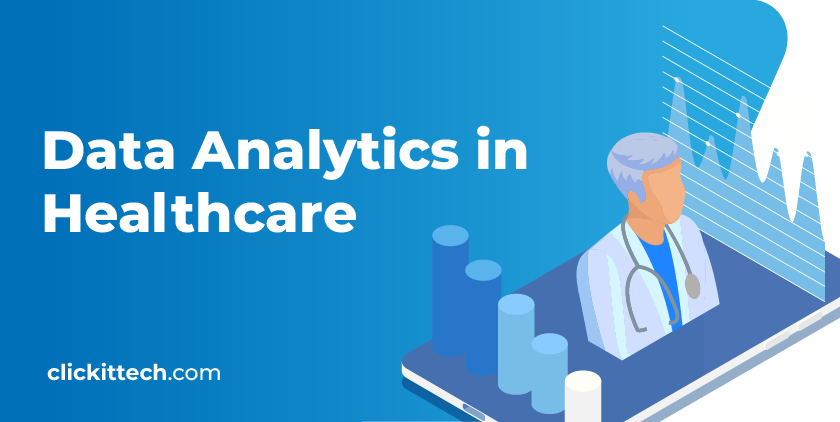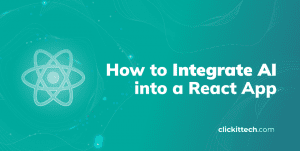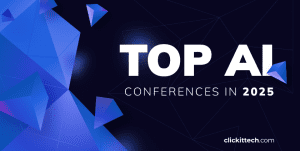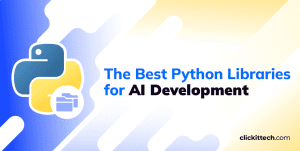How can analyzing vast amounts of data save lives in the healthcare industry? Data analytics in Healthcare is doing just that, transforming healthcare by turning complex data into actionable insights. The healthcare industry generates enormous quantities of data from patient records, clinical trials, medical imaging, and wearable devices. Data analytics in Healthcare enables providers to improve patient outcomes, enhance operational efficiency, reduce costs, and drive innovations in treatment and care delivery.
- Types of Healthcare Analytics
- How to use Data Analytics in Healthcare
- Transformative Data Analytics Technologies for Healthcare
- Conclusion of Data Analytics in Healthcare
- FAQs
The healthcare analytics market is experiencing significant growth and is poised for substantial expansion in the coming years. As of 2024, the global healthcare analytics market size is estimated to be around USD 46.5 billion. This market is projected to reach USD 130.49 billion by 2029, reflecting a compound annual growth rate (CAGR) of 22.92% from 2024 to 2029.
Data Analytics in Healthcare offers transformative benefits across various aspects of patient care and operational efficiency. By harnessing the power of data, healthcare providers can:
- Better Patient Care:
Individualized treatment plans, early intervention techniques, and better patient outcomes are made possible by the analysis of patient data.
- More Timely and Accurate Diagnoses:
With the use of sophisticated analytics tools, medical practitioners may diagnose patients more quickly and accurately, which improves patient satisfaction and treatment choices. - Better Staffing:
By forecasting patient demand, optimizing staffing levels, and improving staff allocation, predictive analytics can guarantee the best possible patient care delivery. - Increased Operational Efficiency:
Predictive analytics for resource planning, automated regular tasks, and optimized workflows enhance hospital operations and lessen administrative stress. - Empowered Decision Making:
Data-driven insights enable healthcare professionals to make well-informed decisions about treatment procedures and resource allocation. - Greater Insights into Public Health:
Real-time analytics facilitate the tracking of population health patterns, the timely identification of disease outbreaks, and the implementation of focused public health initiatives. - Data Security and Privacy:
Strong security features in analytics platforms protect patient data, guaranteeing adherence to medical rules and upholding patient confidence. - Assistance with Research and Clinical Trials:
Analytics tools make it easier to analyze big amounts of data, which helps with research and speeds up the creation of new medications.

Types of Healthcare Analytics
Healthcare Analytics encompasses various methodologies and tools that healthcare organizations use to gain insights from data. These methodologies can be categorized into four main types:
- Descriptive Analytics:
Summarising historical data to comprehend past occurrences and trends is the main goal of descriptive analytics.
Descriptive analytics, for instance, can be used in the healthcare industry to plan and manage resources by analysing patient admissions data collected over the course of the previous year to find seasonal patterns in hospital visits. - Predictive Analytics:
Based on previous data, predictive analytics forecasts future occurrences or outcomes by using statistical algorithms and machine learning approaches.
Predictive analytics, for example, can be used to identify patients who are at high risk of readmission within 30 days after discharge, which allows medical professionals to take preventive action and provide individualised follow-up care. - Prescriptive Analytics:
Prescriptive analytics is a type of analytics that goes beyond descriptive and predictive analytics. It makes recommendations for particular actions to take in order to attain desired results.
Prescriptive analytics in healthcare can recommend the best course of action for a patient with a chronic illness by evaluating several treatment choices and projecting their possible efficacy according to the patient’s individual genetic profile and medical history. - Discovery Analytics:
Discovery analytics is the process of looking through data to find insights, connections, and hidden patterns that might not be immediately obvious.
In genomics research, for instance, discovery analytics can be used to find novel genetic markers linked to certain diseases, which could result in the creation of creative diagnostic tools and focused treatments.
How to use Data Analytics in Healthcare
Data Analytics plays a crucial role in transforming healthcare by providing actionable insights and improving decision-making processes. Here are key areas where data analytics is applied:
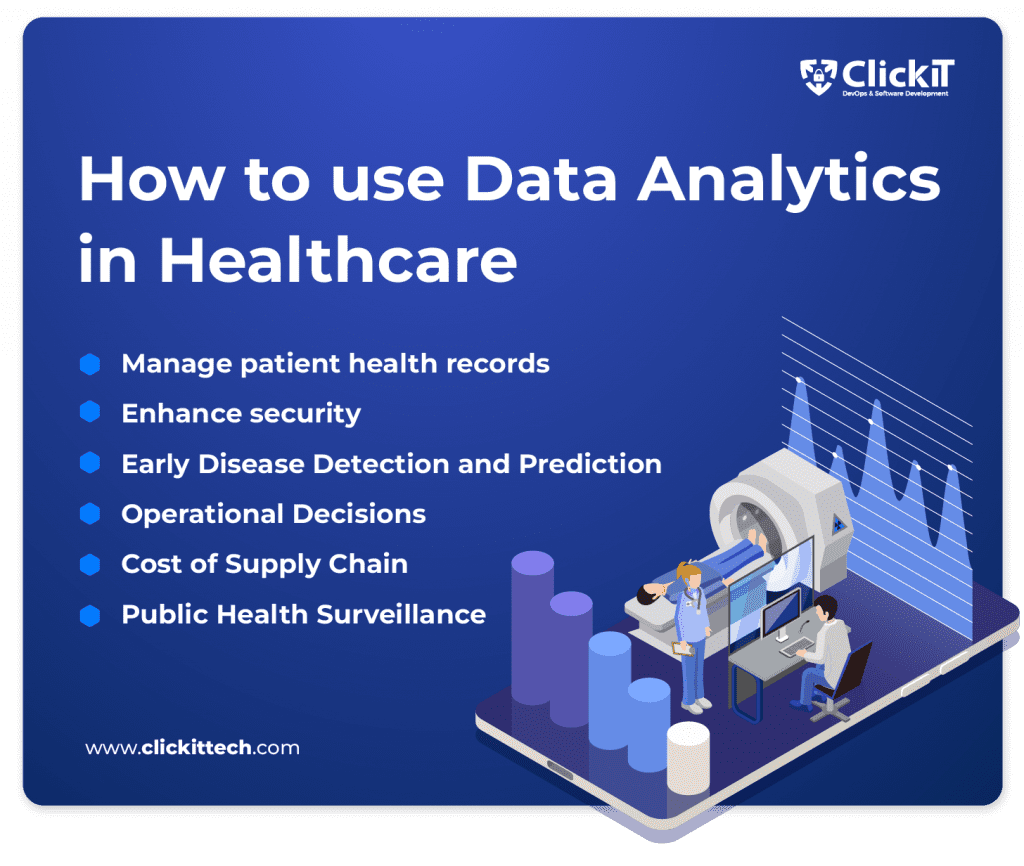
- Manage patient health records:
Electronic health records (EHRs) are centralized and managed by data analytics, which makes it easy for medical professionals to obtain comprehensive patient data. It enhances clinical decision-making, expedites the retrieval of medical histories, and increases data accuracy. - Enhance security:
Advanced analytics tools keep an eye out for and detect unauthorized access to patient data, spot possible security breaches, and guarantee adherence to HIPAA and other healthcare rules. To improve data security and safeguard patient privacy, anomaly detection techniques, access limits, and data encryption are used. - Early Disease Detection and Prediction:
To determine who is most likely to develop a given disease, predictive analytics algorithms examine patient data, including symptoms, genetic information, and lifestyle factors. Proactive interventions, individualized treatment regimens, and enhanced health outcomes are made possible by early identification. - Operational Decisions:
By streamlining workflows, allocating resources effectively, and optimizing hospital operations, healthcare administrators employ analytics. Forecasting patient demand, staff scheduling, wait time reduction, and overall patient satisfaction are all improved by predictive modeling. - Cost of Supply Chain:
Analytics tools monitor and examine data from the supply chain, such as supplier performance, inventory levels, and procurement costs. Healthcare organizations may save operating expenses, cut waste, and guarantee timely delivery of medical supplies and equipment by optimizing their supply chain management. - Public Health Surveillance:
Real-time analytics track disease outbreaks, keep tabs on population health trends and evaluate the success of public health initiatives. Data analytics is used by researchers and public health officials to pinpoint disease hotspots, distribute funds for illness prevention, and launch focused health initiatives.
You can also read our guide for successful Healthcare Software development.
Transformative Data Analytics Technologies for Healthcare
Data analytics tools are transforming the way healthcare organizations interpret and use data to improve clinical results, operational efficiency, and patient care in the quickly changing healthcare landscape. These technologies cover a wide range of tools and systems that let medical professionals extract insightful information from enormous volumes of medical data.
Healthcare companies may make educated judgments, promote therapeutic breakthroughs, and streamline the delivery of healthcare by utilizing big data analytics, advanced data warehousing, machine learning, artificial intelligence, and visualization tools.
Now let’s explore the major data analytics technologies that are changing the healthcare sector:
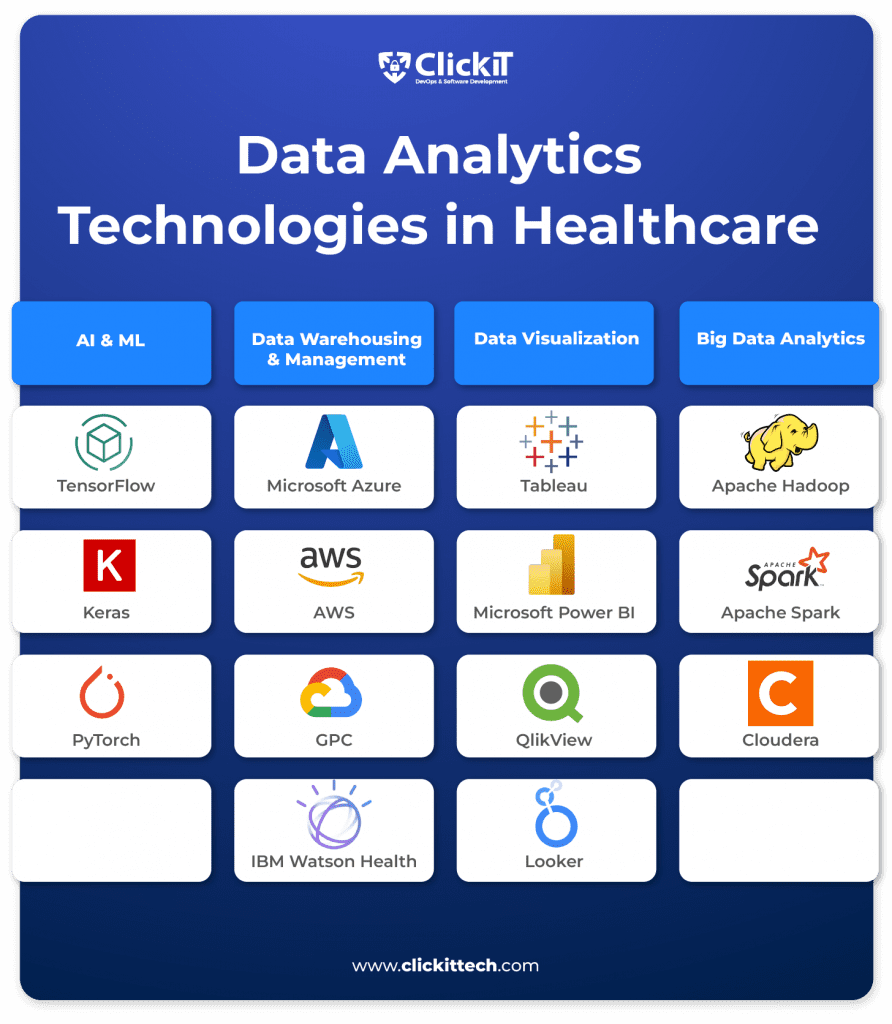
Artificial Intelligence and Machine Learning
Healthcare relies heavily on artificial intelligence (AI) and machine learning (ML) due to their superior decision-making capabilities and capacity to analyze large, complicated information. While ML models allow for personalized treatment plans and medication development, AI algorithms are capable of interpreting medical pictures, predicting patient outcomes, and automating administrative procedures.
TensorFlow
TensorFlow is an open-source machine learning framework developed by Google that is compatible with numerous healthcare applications. It is particularly good at creating and refining deep learning models for predictive analytics, natural language processing (NLP), and medical picture analysis. TensorFlow is the recommended option for creating AI-driven healthcare solutions because of its scalability and versatility.
E.g. : GE Healthcare used TensorFlow to train a neural network designed to identify specific anatomical structures during brain MRI exams, enhancing both speed and consistency in the imaging process.
Keras
Python-based Keras is an open-source neural network library. It is intended to facilitate rapid deep neural network testing and is compatible with several backends, such as TensorFlow and Theano. Personalized treatment planning, disease prediction, picture recognition, and deep learning models are all made possible by healthcare professionals using Keras.
PyTorch
Another well-liked open-source machine learning framework, PyTorch, was created by Facebook’s AI Research lab (FAIR) and is renowned for its user-friendliness and dynamic computational graph. In the medical field, PyTorch is extensively employed for applications including clinical decision support systems, genomic data processing, and medical image analysis. Because of its adaptability and support for GPU acceleration, it can be used in healthcare settings for both production and research situations.
E.g. : MONAI used PyTorch to develop advanced neural networks for medical image segmentation, such as identifying and delineating tumors and organs in MRI and CT scans. This enhances precision and reliability in medical imaging, accelerating research and clinical integration.
Rely on LATAM Data Scientists who combine technical expertise with an innovative mindset to make your business thrive alongside top-notch AI & Machine Learning development services.
Data Warehousing and Management
Data Analytics in Healthcare relies on securely and effectively storing, managing, and analyzing healthcare data, which requires effective data warehousing and management solutions. These solutions provide data security, scalability, and adherence to HIPAA and other healthcare laws.
Microsoft Azure
For data management, analytics, and storage, healthcare organizations utilize Azure’s extensive suite of cloud services. Performance, security, and compliance-focused managed SQL Server databases are available with Azure SQL Database. Azure Cosmos DB is a worldwide distributed database service that offers high availability and low latency data access for healthcare applications. It supports a variety of data types.
AWS
Healthcare providers use AWS’s extensive suite of cloud computing services for analytics, processing, and data storage. Healthcare data is stored in scalable object storage using Amazon S3 (Simple Storage Service), which guarantees robustness and security. Healthcare companies may execute sophisticated queries and carry out large-scale data analysis with Amazon Redshift, a fully managed data warehouse service.
As an AWS Advancer Partner, ClickIT operates your infrastructure and optimizes it for scalability. Contact Us
GCP
GCP offers tools designed specifically for the healthcare industry, like BigQuery and the Healthcare API, which are used to store and analyze healthcare data. The Healthcare API facilitates the assimilation, manipulation, and interpretation of electronic health records (EHRs) and additional healthcare data formats by healthcare practitioners. Healthcare machine learning and real-time analytics are supported by BigQuery, a serverless, highly scalable data warehouse.
IBM Watson Health
IBM Watson Health helps researchers and healthcare professionals derive insights from medical data by combining AI and data analytics. Watson Health offerings include Watson Discovery Advisor, which expedites drug discovery by evaluating scientific literature and clinical trial data, and Watson for Oncology, which offers cancer patients evidence-based therapy recommendations.
Data Visualization Tools
Big Data Analytics in Healthcare significantly benefits from data visualization tools. With the use of data visualization technologies, medical professionals can more easily obtain insights and effectively convey their findings by transforming complex medical data into clear visual representations.
Tableau
Healthcare companies utilize Tableau, a top analytics and data visualization tool, to build interactive dashboards, reports, and visualizations. Tableau Desktop enables users to connect to a range of data sources, such as databases for healthcare and EHR systems, in order to analyze population health trends, operational metrics, and patient outcomes.
E.g. : The EVP of Operations at Ochsner Health System, Louisiana’s largest non-profit academic healthcare system, mandated that every interaction counts. The analytics team used Tableau to integrate third-party survey data with demographics and interaction data, making NPS scores actionable for executives, clinic managers, and doctors. Now, everyone can track their performance against goals and gain deeper insights to enhance customer experiences.
Microsoft Power BI
Power BI provides self-service business intelligence features that let medical professionals examine and visualize data from various sources. Users of Power BI Desktop can generate dynamic reports and dashboards that offer financial indicators, clinical performance, and patient profiles. For real-time data analytics, Power BI easily interfaces with other healthcare IT systems and Azure services.
E.g. : Humana leveraged the combined capabilities of Power BI and Microsoft Azure to enhance their healthcare offerings beyond traditional coverage. By utilizing Power BI’s advanced data visualization and Azure’s robust cloud services, Humana developed a self-service reporting platform that provides a comprehensive, unified profile of their members. This platform enables Humana to design proactive healthcare programs aimed at reducing health risks for their customers.
QlikView
QlikView helps healthcare organizations analyze patient data, allocate resources optimally, and enhance the quality of care they give by using business intelligence and data visualization solutions. Users may dynamically examine data associations and uncover hidden insights with QlikView’s associative model, which helps healthcare settings make well-informed decisions.
Looker
Healthcare providers may extract insights from intricate datasets by utilizing Looker, a platform for business intelligence and data discovery. Healthcare teams may examine clinical data, operational indicators, and patient outcomes with greater effectiveness thanks to Looker’s design, which facilitates data modeling, exploration, and collaboration.
E.g. : Commonwealth Care Alliance used Looker to track and respond to the impact of COVID-19 on member needs. Looker’s data visualization helped them quickly adapt their services to meet changing healthcare demands during the pandemic.
Big Data Analytics in Healthcare
Big Data technologies manage vast and heterogeneous datasets, enabling predictive modeling, real-time analytics, and pattern recognition that propels breakthroughs in healthcare.
Apache Hadoop
The open-source Apache Hadoop platform makes the distribution and storage of massive datasets across computer clusters possible. Data gathering, analysis, and predictive modeling are performed in the healthcare industry using Hadoop:
- Scalable Storage:
Thanks to Hadoop’s Hadoop Distributed File System (HDFS), healthcare institutions can stably and affordably store enormous volumes of both structured and unstructured data. - Processing data:
By dividing enormous data sets into smaller pieces and processing them concurrently, Hadoop’s MapReduce programming methodology makes processing data easier. Analysing massive healthcare data sets, including genomic sequences and patient records, requires this. - Integration:
Hadoop provides a robust environment for healthcare data analytics through its integration with other big data tools and platforms.
E.g. :Explorys, a Cleveland Clinic spinoff, leverages Hadoop to manage and analyze an enormous healthcare database with over 100 billion data points. This big data approach supports real-time analysis of diverse information, including financial and electronic health records, enhancing clinical support and managing at-risk patient populations.
Apache Spark
Real-time analytics in the healthcare industry benefit greatly from the speed and versatility of Apache Spark, an all-purpose cluster computing system with in-memory data processing capabilities.
- Real-Time Processing:
Spark’s in-memory computing powers make it possible to process data in real-time, which is crucial for applications like early illness diagnosis and patient monitoring. - Machine Learning:
Healthcare organizations can leverage Spark’s scalable machine learning library, MLlib, to create predictive models for patient outcomes, disease prediction, and customized therapy regimens. - Data Streaming:
Healthcare providers may now analyze data from medical devices and wearables in real-time by using Spark Streaming, which enables real-time processing of streaming data.
Cloudera
Cloudera offers enterprise-grade data management and analytics solutions built on Apache Hadoop and Apache Spark, tailored for healthcare environments.
- Data management:
Cloudera’s platform offers strong capabilities for data governance, security, and regulatory compliance, guaranteeing safe and effective management of healthcare data. - Integrated Solutions:
By integrating with healthcare IT systems, Cloudera Data Platform (CDP) offers a single platform for data processing, analytics, and ingestion. - Advanced Analytics:
Cloudera facilitates the use of advanced analytics, such as AI and machine learning, which helps healthcare companies extract knowledge from their data and innovate how they provide care.
Read our blog IoT Healthcare Solutions, to innovate your health app

Conclusion of Data Analytics in Healthcare
In conclusion, Data Analytics in Healthcare has the potential to significantly improve patient care, operational effectiveness, and innovation by transforming large amounts of complex data into insightful knowledge. Data-driven strategies are essential in today’s healthcare, as seen by the significant rise of the healthcare analytics industry, which is expected to reach USD 130.49 billion by 2029.
By utilizing smart data analytics, healthcare providers may make better decisions, increase diagnostic accuracy, personalize and expedite care, and guarantee strong data security. Improved staffing, enhanced operational efficiency, enhanced patient care, and expanded public health insights are just a few of the many advantages of Data Analytics in the Healthcare industry.
In healthcare, descriptive, predictive, prescriptive, and discovery data analytics convert unprocessed data into useful insights. These techniques help healthcare organizations better maintain patient records, identify illnesses early, improve security, streamline processes, and monitor public health.
Big Data analytics in healthcare can be improved by state-of-the-art technology including artificial intelligence (AI), machine learning, and big data platforms.
Data analytics will play an increasingly important role in healthcare as the industry continues to change. To stay ahead of the curve, raise the standard of care, and eventually save lives, healthcare organizations must adopt these cutting-edge technology and procedures. The healthcare sector may attain a future where patient care is more effective, efficient, and personalized, improving everyone’s health outcomes by leveraging the power of data analytics.
FAQs
Personalised treatment plans, early disease detection, and more precise diagnostics are all made possible by Data Analytics in Health Care industry. Healthcare practitioners can make better clinical decisions that result in better patient outcomes and satisfaction by identifying patterns and trends from the massive amounts of patient data they analyze.
Descriptive, predictive, prescriptive, and discovery analytics are the primary categories of Data Analytics in Health Care. Predictive analytics predicts future events, prescriptive analytics suggests particular courses of action, descriptive analytics summarises past data, and discovery analytics finds patterns and insights buried inside data.
By making the appropriate investments in technology and tools, such as AI and machine learning platforms, data warehousing systems, and data visualization tools, healthcare organizations can begin applying Big Data Analytics in Health Care. To guarantee data security and quality, it is also crucial to create data governance standards and train employees in data analytics methodologies.

